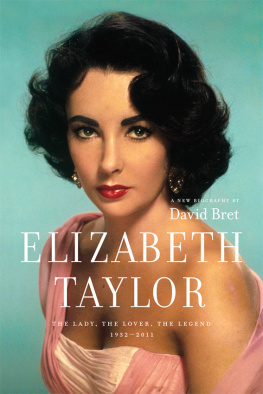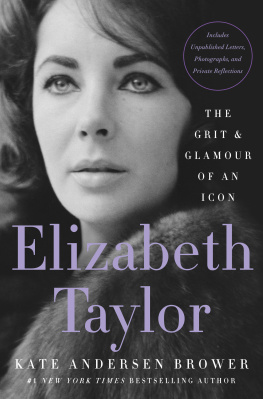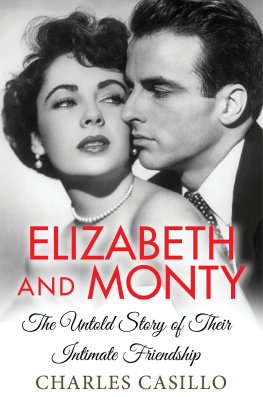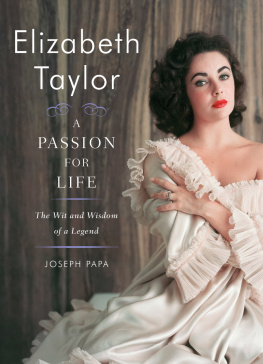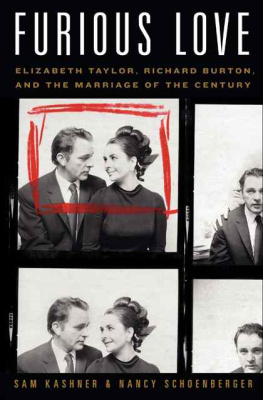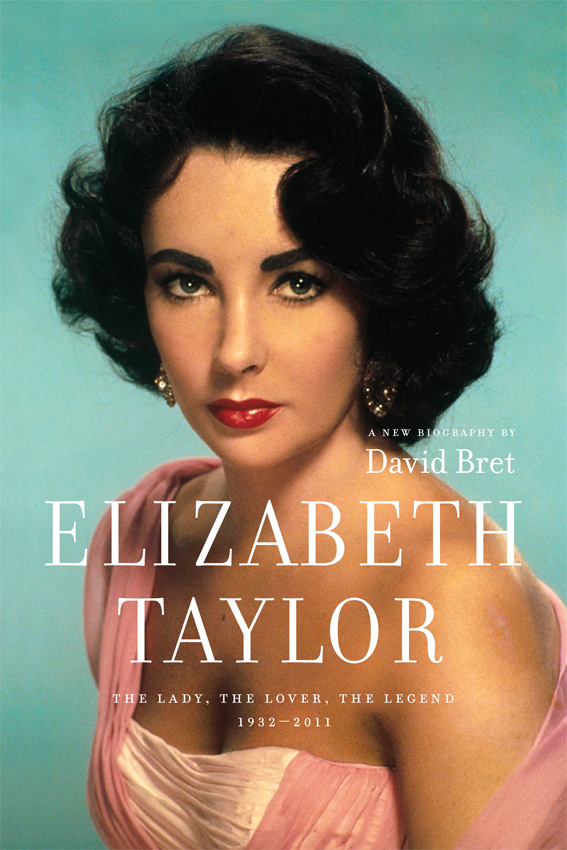
E L I Z A B E T H T A Y L OR
E L I Z A B E T H T A Y L OR
THE LADY, THE LOVER, THE LEGEND
A NEW BIOGRAPHY BY
David Bret
D&M PUBLISHERS INC. Vancouver/Toronto/Berkeley
Copyright 2011 by David Bret
11 12 13 14 15 5 4 3 2 1
All rights reserved. No part of this book may be reproduced, stored in a retrieval system or transmitted, in any form or by any means, without the prior written consent of the publisher or a licence from The Canadian Copyright Licensing Agency (Access Copyright). For a copyright licence, visit www.accesscopyright.ca or call toll free to 1-800-893-5777.
Greystone Books
An imprint of D&M Publishers Inc.
2323 Quebec Street, Suite 201
Vancouver BC Canada V5T 4S7
www.greystonebooks.com
Published simultaneously in the United Kingdom by Mainstream Publishing Company (Edinburgh) Ltd
7 Albany Street
Edinburgh UK EH 1 3 UG
Cataloguing data available from Library and Archives Canada
ISBN 978-1-55365-440-7 (pbk.)
ISBN 978-1-55365-985-3 (ebook)
Cover design by Peter Cocking
Cover photograph by Francois Lochon/Gamma Rapho/Getty Images
Distributed in the U.S. by Publishers Group West
THIS BOOK IS DEDICATED TO
Barbara, La grande chanteuse Am lia Rodrigues,
Joey Stefano, Dorothy Squires, Henry, Eden, Fritzi, Adeline
and Les Enfants de Novembre
Noublie pas...
La vie sans amis
cest comme un jardin sans fleurs
ACKNOWLEDGEMENTS
WRITING THIS BOOK WOULD NOT HAVE BEEN POSSIBLE had it not been for the inspiration, criticisms and love of that select group of individuals who, whether they be in this world or the next, I will always regard as my true family and autre coeur.
Barbara, Irene Bevan, Marlene Dietrich, Ren Chevalier, Axel Dotti, Dorothy Squires and Roger Normand, que vous dormez en paix . Lucette Chevalier, Jacqueline Danno, Hlne Delavault, Tony Griffin, Betty and Grard Garmain, Annick Roux, John and Anne Taylor, Terry Sanderson, Charley Marouani, David and Sally Bolt. Also a very special mention for Amlia Rodrigues, Joey Stefano, those hiboux , fadistas and amis de foutre who happened along the way, and mes enfants perdus .
Very many thanks to Bill Campbell and the munificent team at Mainstream. Likewise my agent Guy Rose and his lovely wife, Alex. Also to my wife, Jeanne, for putting up with my bad moods and for still being the keeper of my soul.
And finally a grand chapeau bas to Elizabeth, for having lived it.
David Bret
CONTENTS
Mothers Little Dividend
Move Over, Shirley Temple
With This Fist, I Thee Wed
English without Tears
A Date with Jimmy and Rock
Lizzie Schwartzkopf, My Jewish Broad!
Pass the Parcel, Mike
The Launch of the $40 Million Bomb
That Intemperate Vamp
The Big Hangover: Whos Afraid of Virginia Woolf?
Duds and Diamonds
From Playboys Muse to Farmers Wife
In the Footsteps of Tallulah
Goodbye Rock... Hello Larry
Saint Elizabeth
The Fading Star
The Films of Elizabeth Taylor
INTRODUCTION
ELIZABETH TAYLOR WILL GO DOWN IN HISTORY FOR making more turkeys than acclaimed films, for having an on-screen voice that more than frequently grates and for rarely maintaining the acting standards of her co-stars. Additionally, she will be recalled as one of three Hollywood creations who made the successful transition from precocious child prodigy to adult movie star the others were Judy Garland and Natalie Wood not by talent alone, but by maternal push. Not that this constant surveillance and carping from the wings fashioned lasting success for these women. Judys mother was an ogre who actively endorsed the enforced feeding of uppers and downers to keep the show on the road a selfish action that directly contributed to the early demise of her daughter, something that Ethel Gumm was not around to witness. Maria Gurdin, Natalie Woods mother, was considerably worse, possessed of an overwhelming ego and diminished mental capacity, which caused her to genuinely believe that her machinations were for her daughters good. Sara Taylor was a combination of the two. And who may deny, sifting through the evidence, that she was more than partly responsible assisted by the negative elements of the Hollywood dream factory for her daughters instability, which threw open the floodgates to a whole catalogue of calamities, suicide attempts, collapsed marriages and sabotaged relationships?
Although one cannot doubt that without these ubiquitous Svengalis none of these young women would have made it to the top so quickly, if at all, one cannot ignore the irreparable damage they inflicted on their fragile charges, whose whole lives would be dragged out under enormous clouds of impending gloom. Montgomery Clift, Joan Crawford, Errol Flynn and Elvis Presley may also have endured monster mothers, but they knew how to fight back. Elizabeth Taylor never found the strength to.
The film critic Alexander Walker called her a born survivor, but, as will be seen, this was only partly true. Despite the many genuine concerns about her health, she alone orchestrated the weapons of self-destruction throughout her entire life, deliberately aggravating situations brought about by her own recklessness and folly, often solely for the purpose of contenting the media and keeping her name in the headlines. This she did better than anything witnessed on the screen.
Elizabeth Taylor derived some sort of ghoulish pleasure from home-based drama and self-inflicted adversity, and, as such, remains the prima donna of the worlds show-business elite. Her story all too often makes for grim reading, but it is nevertheless a fascinating one, from which absolutely no punches have been pulled.
MOTHERS LITTLE DIVIDEND
ELIZABETH TAYLOR WAS BORN INTO MONEY, AND THROUGHOUT her entire life never had to compromise or go without. Her father, Francis Lenn Taylor, was born in Springfield, Illinois, in 1897 but raised in Arkansas, Kansas, by parents who ran an express-mail and messenger service. As a youth, he fell for aspiring actress Sara Viola Warmbrodt, one year his senior and the daughter of a local German migr laundry manager.
Any initial romance between the two was, however, short-lived. In November 1918, when Francis turned 21, he was offered an apprenticeship with entrepreneur Howard Young, his uncle on his fathers side. Young, who hailed from St Louis, had amassed much of his fortune from shrewd oil investments and ploughed this back into a successful art-dealing business. The following year, he and Francis opened the Howard Young Gallery in Manhattan.
Sara, meanwhile, had left home to study acting in Kansas City and changed her name to Sara Sothern. By 1922, she was playing a minor role in a Los Angeles production of magicianillusionist Channing Pollocks The Sign on the Door (1921). Pollock next put her into The Fool (1925), playing the part of 15-year-old Crippled Mary Margaret aka Mary Magdalene in this modern version of the St Francis of Assisi story. The critical panning this received coincided with Saras meeting with the great Russian actress and silent-movie icon Alla Nazimova, a close friend of Rudolph Valentino and the doyenne of Hollywoods closeted lesbian clique.
That Sara had even been acknowledged by this powerful, feisty woman almost certainly means that she would have been invited to join Nazimovas infamous lesbian sewing circle. This met regularly at The Garden of Alla, Nazimovas mansion on Sunset Boulevard, where the baritone babes included both of Valentinos wives, Lili Damita (who later married Errol Flynn) and Dolly Wilde (Oscars niece, described by the hostess as the only Wilde who likes women). Even so, Saras membership of Nazimovas circle must have been fleeting for, despite its dreadful reviews, The Fool opened on Broadway at the end of the year. Here, the lead was played by James Kirkwood, already a name in the New York gay community many years later, Saras daughter would appear in his There Must Be a Pony (1986).

